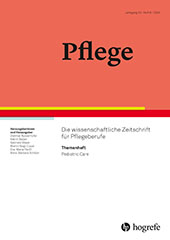Storytelling als innovative Methode zur videobasierten Edukation für Eltern von Kindern mit atopischer Dermatitis
Abstract
Zusammenfassung.Hintergrund: Die atopische Dermatitis (AD) ist eine chronische, rezidivierende Hauterkrankung. Jedes fünfte bis sechste Kind ist in der westlichen Zivilisation davon betroffen. Die Folgen der Erkrankung können gravierend sein: Chronische Entzündung der Haut und plagender Juckreiz verbunden mit Schlafstörungen. Für den Erfolg der Therapie ist die Edukation der Eltern von betroffenen Kindern zentral. Ziel: Entwicklung und Evaluation von evidenzbasierten Edukationsvideos für Eltern von einem Kleinkind mit AD. Methode: In den Videos wurde die Methode Storytelling eingesetzt. Ziel von Storytelling ist, Informationen durch den Einsatz von Geschichten einfach zu vermitteln. Anschließend an die Entwicklung wurden die Videos hinsichtlich der Verständlichkeit, der Wichtigkeit sowie der Nützlichkeit der Inhalte von einem multi-professionellem Team sowie von Familien mit betroffenen Kindern evaluiert. Ergebnisse: Es entstanden insgesamt sechs Videos, welche Themen wie Ursachen der AD, Symptome, Hautpflege, Behandlung sowie Leben mit AD beinhalteten. Storytelling wurde umgesetzt indem zwei Familien mit betroffenen Kindern von ihren Erfahrungen mit der Erkrankung erzählten. Fachinformationen wurden durch Spezialistinnen vermittelt. Die Evaluation ergab, dass die Informationen in den Videos einfach verständlich und relevant sind. Schlussfolgerungen: Mit evidenzbasierten Videos kann die Edukation auf innovative, kreative und moderne Art und Weise gefördert werden. Storytelling ist eine nutzerfreundliche Methode um komplexe Informationen einfach und verständlich zu vermitteln.
Abstract.Background: Atopic Dermatitis (AD) is the most chronic skin disease in children and affects up to 20 % of children in developed countries. Chronic inflammation of the skin, itching, redness, and non-dermatologic symptoms like sleep disturbance are frequent and have a negative impact on the child’s quality of life and their family. Education is one of the most important aspects of managing AD. Aim: Production and evaluation of educational videos with the method storytelling for parents of children aged 0 to 5 years with atopic dermatitis. Methods: We produced the videos with the method of storytelling. The aim of storytelling is to help to recall important information more easily. A multi-professional team and parents of affected children tested the videos to ensure the understandability, the helpfulness and importance of the educational videos. Results: We created six different videos in all. The content of the educational videos includes information on the causes of AD, symptoms, skin care, treatment instruction and living with AD. We implemented the method of storytelling by two families with affected children who reported about their experience with the disease and the treatment. Three different specialists gave expert information. The evaluation showed that the information in the videos is simple, understandable and relevant. Conclusions: Evidence-based videos are an innovative, creative and modern method to support education. Storytelling is a user-friendly method to give simple and understandable information.
Literatur
(2011). Online video improves clinical outcomes in adults with atopic dermatitis: a randomized controlled trial. Journal of the American Academy of Dermatology, 64 (3), 502 – 507.
(2006). Worldwide time trends in the prevalence of symptoms of asthma, allergic rhinoconjunctivitis, and eczema in childhood: ISAAC Phases One and Three repeat multicountry cross-sectional surveys. The Lancet, 368 (9537), 733 – 743.
(2013). Therapeutic patient education in children with atopic dermatitis: position paper on objectives and recommendations. Pediatric dermatology, 30 (2), 199 – 206.
(2002). Improving primary care for patients with chronic illness. Jama, 288 (14), 1775 – 1779.
(2014). Psychological and educational interventions for atopic eczema in children. Cochrane Database of Systematic Reviews, CD004054.
(2018). A cross-sectional study of YouTube videos about atopic dermatitis. Journal of the American Academy of Dermatology, 78 (3), 612 – 613.
(2018). Warum das Gehirn Geschichten liebt-inkl. Augmented-Reality-App:Storytelling-analog und digital (4. Auflage). Freiburg: Haufe-Lexware.
(2011). Kinderdermatologie: Differenzialdiagnostik und Therapie bei Kindern und Jugendlichen. Stuttgart: Schattauer Verlag.
(2018). Mythen in der Pädiatrie: Atopisches Ekzem. Monatsschrift Kinderheilkunde, 166 (12), 1100 – 1104.
(2011). Guidelines to Management of Atopic Dermatitis. In: A. D. Irvine, P. H. Hoeger & A. C. Yan (Eds.), Harpers’s Textbook of Pediatric Dermatology (3rd edition). Oxford: Wiley-Blackwell.
(2015). Digital storytelling: an innovative tool for practice,education, and research. Occupational therapy in health care, 29 (1), 54 – 62.
(2017). Topical corticosteroid phobia in atopic dermatitis: a systematic review. JAMA dermatology, 153 (10), 1036 – 1042.
(2013). Improved emollient use reduces atopic eczema symptoms and is cost neutral in infants: before-and-after evaluation of a multifaceted educational support programme. BMC dermatology, 13 (1), 7.
(2018). Digital storytelling in health professions education: a systematic review. BMC medical education, 18 (1), 208.
(2012). Update on topical glucocorticoid use in children. Current opinion in pediatrics, 24 (1), 121 – 128.
Pan American Health Organization (PAHO) & World Health Organization (WHO) (2013). Innovative Care for Chronic Conditions: Organizing and Delivering High Quality Care for Chronic Noncommunicable Diseases in the Americas. Verfügbar unter https://www.paho.org/hq/dmdocuments/2013/PAHO-Innovate-Care-2013-Eng.pdf [15.12.2019].Schweizerische Akademie der Medizinischen Wissenschaften (2016). Patienten und Angehörige beteiligen. Swiss Academies Communications, 11 (10).(2014). Guidelines of care for the management of atopic dermatitis: Section 4. Prevention of disease flares and use of adjunctive therapies and approaches. Journal of the American Academy of Dermatology, 71 (6), 1218 – 1233.
(2013). Therapeutic patient education in atopic dermatitis: worldwide experiences. Pediatric dermatology, 30 (3), 329 – 334.
(2015). Alternativmedizin und atopisches Ekzem. Wissenschaftliche Datenlage zu den einzelnen Methoden. Dermatologie Praxis, 25 (6), 2 – 5.
(2012). Hauterkrankungen des Säuglings. Aktuelle Dermatologie, 38 (12), 477 – 492.
(2018). Consensus-based European guidelines for treatment of atopic eczema (atopic dermatitis) in adults and children: part I. Journal of the European Academy of Dermatology and Venereology, 32 (6), 850 – 878.
New York Film Academy (2019, January 4). Mastering the 7 Stages of Film Production. Verfügbar unter https://www.nyfa.edu/student-resources/7-stages-film-production [15.01.2020].



